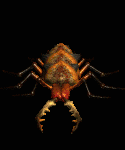No edit summary |
m (clean up) |
||
| (4 intermediate revisions by 3 users not shown) | |||
| Line 1: | Line 1: | ||
| − | [[ |
+ | [[Image:Sandmaggot.gif|right]] |
| − | These rather large bugs are found in the deserts of [[Aranoch]] and even near [[River of Flame |
+ | These rather large bugs are found in the deserts of [[Aranoch]] and even near [[River of Flame|rivers of flame]] in [[Burning Hells|Hell]]. They have numerous pairs of legs on their sides and have large pincers. Their exoskeleton serves as a tough shell that protects them from attack. They have the ability to spit poison at their prey and when threatened, they may burrow into the ground and emerge from beneath for an effective ambush. Sand Maggots lay [[Sand Maggot Egg|eggs]] on the ground. Given enough time, the eggs soon hatch and spew forth a few [[Sand Maggot Young]]. Their non-matured offspring are a less serious threat than themselves. Given by [[Geglash]]'s advice, Sand Maggots aren't recommended against by using crossbows or other long-range weapons due to their thick armor and can only by easily taken down by using melee weapons. They have a fairly slow attack speed which makes them easier to defeat. |
Sand Maggots come in four other variants: [[Rock Worm]], [[Devourer]], [[Giant Lamprey]], and [[Blood Maggot]]. |
Sand Maggots come in four other variants: [[Rock Worm]], [[Devourer]], [[Giant Lamprey]], and [[Blood Maggot]]. |
||
| − | Sand Maggots are immune to [[Poison]] on Hell Difficulty. |
+ | Sand Maggots are immune to [[Poison]] on [[Hell Difficulty]]. |
| − | A |
+ | A [[super unique]] Sand Maggot is [[Coldworm the Burrower]]. |
==Background== |
==Background== |
||
| Line 15: | Line 15: | ||
[[Category:Act II Bestiary]] |
[[Category:Act II Bestiary]] |
||
[[Category:Diablo II Bestiary]] |
[[Category:Diablo II Bestiary]] |
||
| − | [[Category: |
+ | [[Category:Monsters]] |
Revision as of 00:22, 14 December 2008
These rather large bugs are found in the deserts of Aranoch and even near rivers of flame in Hell. They have numerous pairs of legs on their sides and have large pincers. Their exoskeleton serves as a tough shell that protects them from attack. They have the ability to spit poison at their prey and when threatened, they may burrow into the ground and emerge from beneath for an effective ambush. Sand Maggots lay eggs on the ground. Given enough time, the eggs soon hatch and spew forth a few Sand Maggot Young. Their non-matured offspring are a less serious threat than themselves. Given by Geglash's advice, Sand Maggots aren't recommended against by using crossbows or other long-range weapons due to their thick armor and can only by easily taken down by using melee weapons. They have a fairly slow attack speed which makes them easier to defeat.
Sand Maggots come in four other variants: Rock Worm, Devourer, Giant Lamprey, and Blood Maggot.
Sand Maggots are immune to Poison on Hell Difficulty.
A super unique Sand Maggot is Coldworm the Burrower.
Background
Sand Maggots, named for their burrowing abilities, are actually arthropods and not worms at all. These insects were once a staple diet for those that resided in the desert regions. The eggs were gathered and prepared as a protein-rich paste. Serving to supplement the dry foods naturally available in the region, the paste enhanced the nutritive value and flavor of meals. Now, however, the eggs, larvae, and flesh of the adults have acquired poisonous properties. Adults of the species even spit a poisonous substance that is not only toxic, but corrosive to unprotected flesh. In maturity, the chitinous exoskeleton of a Maggot is tough to penetrate, although once pierced, the creature is easily felled.
Sand Maggot • Rock Worm • Devourer • Giant Lamprey • Blood Maggot

